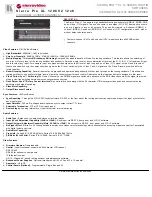
4
Operating instructions
Safety foot switches
TFH 232 AS
EN
6. Diagnostic
6.1 Internal LED indications
The LED's have the following meaning (to EN 50295):
Yellow LED:
Channel 1 / AS-i SaW-Bit 0,1
LED green/red
(AS-i duo LED):
AS-Interface supply voltage/
AS-Interface communication error or
slave address = 0
or periphery error
Yellow LED:
Channel 2 / AS-i SaW-Bit 2,3
6.2 Read-out of the parameter ports
The parameter port P0 to P3 of an AS-i slave can be read out through
the control interface of the AS-i master (see component description) by
means of the "Write parameter" instruction (with hexadecimal value F)
This (non-safe) diagnostic information from the reflected parameters or
the answer to a "Write parameter instruction" can be used by the user
for diagnostic purposes or for the control programme
Table 3: diagnostic information (P0 … P3)
Parameter bit
Condition = 1
Condition = 0
0
Channel 2 activated
Channel 2 disabled
1
—
—
2
—
—
3
—
—
7. Set-up and maintenance
7.1 Functional testing
The safety function of the safety components must be tested The
following conditions must be previously checked and met:
1 Check the integrity of the cables and connections
2 Check the switch enclosure for damage
3 Check the functionality of the switch by actuating the safety foot
switch
7.2 Maintenance
The safety function of the safety foot switch must be tested at regular
intervals
A regular visual inspection and functional test, including the following
steps, is recommended:
• Check of the safety function
• Check the switch enclosure for damages
• Possible soiling accumulated below the foot pedal must be removed
• Check the integrity of the cables and connections
Damaged or defective components must be replaced.
8. Disassembly and disposal
8.1 Disassembly
The safety switchgear must be disassembled in a de-energised
condition only
8.2 Disposal
The safety switchgear must be disposed of in an appropriate manner in
accordance with the national prescriptions and legislations
























